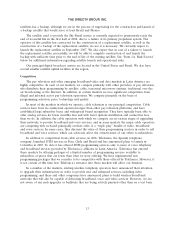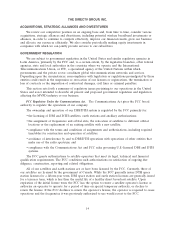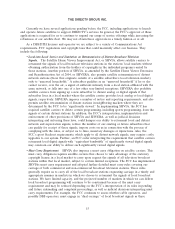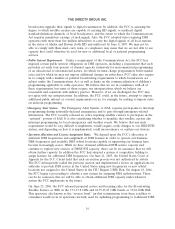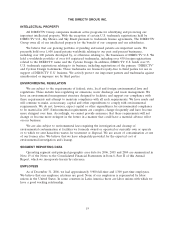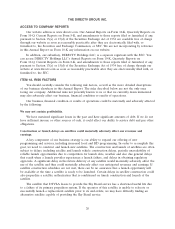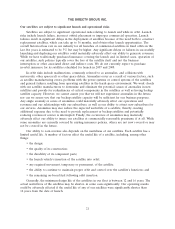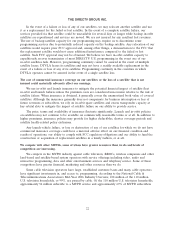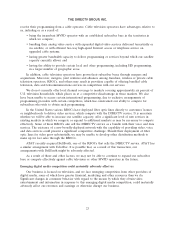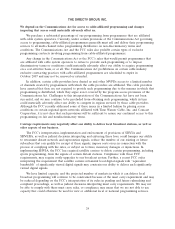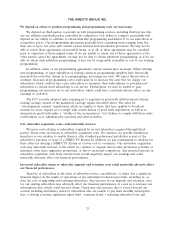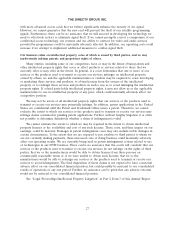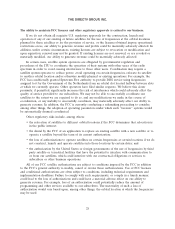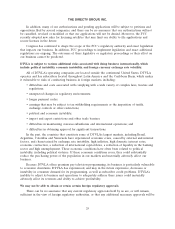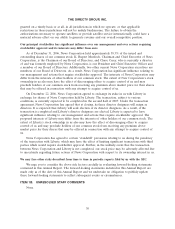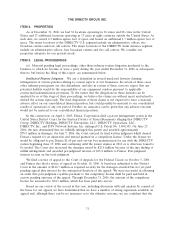DIRECTV 2006 Annual Report Download - page 33
Download and view the complete annual report
Please find page 33 of the 2006 DIRECTV annual report below. You can navigate through the pages in the report by either clicking on the pages listed below, or by using the keyword search tool below to find specific information within the annual report.THE DIRECTV GROUP, INC.
In the event of a failure or loss of any of our satellites, we may relocate another satellite and use
it as a replacement for the failed or lost satellite. In the event of a complete satellite failure, our
services provided via that satellite could be unavailable for several days or longer while backup in-orbit
satellites are repositioned and services are moved. We are not insured for any resultant lost revenues.
The use of backup satellite capacity for our programming may require us to discontinue some
programming services due to potentially reduced capacity on the backup satellite. Any relocation of our
satellites would require prior FCC approval and, among other things, a demonstration to the FCC that
the replacement satellite would not cause additional interference compared to the failed or lost
satellite. Such FCC approval may not be obtained. We believe we have in-orbit satellite capacity to
expeditiously recover transmission of most DIRECTV U.S. programming in the event one of our
in-orbit satellites fails. However, programming continuity cannot be assured in the event of multiple
satellite losses. DTVLA leases its satellites and may not have a readily available replacement in the
event of a failure or loss of any of its satellites. Programming continuity in the countries in which
DTVLA operates cannot be assured in the event of a single satellite loss.
The cost of commercial insurance coverage on our satellites or the loss of a satellite that is not
insured could materially adversely affect our earnings.
We use in-orbit and launch insurance to mitigate the potential financial impact of satellite fleet
in-orbit and launch failures unless the premium costs are considered uneconomic relative to the risk of
satellite failure. When insurance is obtained, it generally covers the unamortized book value of covered
satellites. Although the insurance generally does not compensate for business interruption or loss of
future revenues or subscribers, we rely on in-orbit spare satellites and excess transponder capacity at
key orbital slots to mitigate the impact of satellite failure on our ability to provide service.
The price, terms and availability of insurance fluctuate significantly. Launch and in-orbit policies
on satellites may not continue to be available on commercially reasonable terms or at all. In addition to
higher premiums, insurance policies may provide for higher deductibles, shorter coverage periods and
satellite health-related policy exclusions.
Any launch vehicle failure, or loss or destruction of any of our satellites for which we do not have
commercial insurance coverage could have a material adverse effect on our financial condition and
results of operations, our ability to comply with FCC regulatory obligations and our ability to fund the
construction or acquisition of replacement satellites in a timely fashion, or at all.
We compete with other MVPDs, some of whom have greater resources than we do and levels of
competition are increasing.
We compete in the MVPD industry against cable television, RBOCs, wireless companies and other
land-based and satellite-based system operators with service offerings including video, audio and
interactive programming, data and other entertainment services and telephony service. Some of these
competitors have greater financial, marketing and other resources than we do.
Some cable television operators have large, established customer bases and many cable operators
have significant investments in, and access to, programming. According to the National Cable &
Telecommunications Association’s Mid-Year 2006 Industry Overview, 108 million of the 110 million
U.S. television households, or 99%, are passed by cable. Of the 110 million U.S. television households,
approximately 94 million subscribe to a MVPD service and approximately 69% of MVPD subscribers
22



